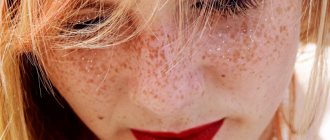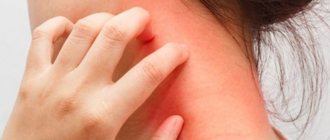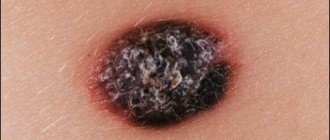Problems with the functionality of the kidneys or liver, stomach and intestines can cause the appearance of red spots on the legs below the knee. To determine the real cause of the pathology, you need to undergo an examination.
Redness of the legs above or below the knees: mechanical causes
First of all, you need to avoid rubbing and rubbing the skin of the extremities with clothing, furniture, and auxiliary devices. If spots on the skin appear due to contact with objects or inconvenient everyday life, then first of all it is necessary to exclude mechanical damage. Perhaps this will solve the redness problem.
Possible reasons
Red or purple spots may be a simple irritation due to the rough fabric of clothing or mechanical rubbing. In this case, it is enough to exclude the irritating element. It's worse if the irritation is caused by a disease.
Atopic dermatitis in older people
Small lumps are localized on the buttocks, thighs and knees.
Fungus
The spots are accompanied by peeling and itching. There are fewer and fewer healthy areas, and the affected skin constantly hurts.
Varicose veins
Vascular spots partially repeat the venous pattern on the legs.
Vasculitis
This is a systemic autoimmune lesion of the walls of blood vessels. The rash is localized below the knees and is accompanied by swelling and inflammation.
Diabetes
Large spots are localized on the legs and sometimes the knees. As the disease develops, the spots become bright burgundy.
Hemangioma
Benign vascular tumor. The spots do not hurt or itch, but have a risk of malignant degeneration.
Avitaminosis
Usually, with vitamin deficiency, the spots are small and dark.
Insect bites
Redness and rash from the bites of ants, mosquitoes, wasps, and midges are a completely natural reaction of a healthy body to the poison injected by insects.
Autonomic disorders
“Nervousness” may also cause itching and flaking as a result of scratching.
Eczema
Over time, the rash from eczema turns into small ulcers, the skin becomes covered with itchy blisters, and an inflammatory process develops.
Psoriasis
A rash in the form of pink plaques appears on joints, skin folds, and areas of skin covered by clothing. During exacerbation, the rash becomes brighter; during remission, the spots become lighter and may disappear completely. .
Lichen
An infectious disease that affects the entire length of the legs. The so-called shingles is concentrated on the thighs.
Burn
Depending on the depth of the lesion, the spots may be darker or lighter. The skin at the site of the spots is very sore and may come off in flakes or patches. The same symptoms characterize chapping and frostbite.
Heredity
If the parents had specific age-related pigmentation, then the children are likely to inherit it. But do not forget that following the rules of healthy eating and hygiene can significantly mitigate the symptoms.
Spots in bedridden patients: red, blue, black - on the legs and body
If spots appear on the body of a bedridden elderly person, this cannot be ignored. This article lists the most common causes of stains, but it is always better to contact a specialist, even if you find a case very similar to yours. White spots
Such spots indicate insufficient blood flow to the cells and anemia. Small capillaries may stick together.
Red spots
In a bedridden elderly person, red spots signal the appearance of a bedsore, tissue death, and problems with the removal of waste products from cells.
Blue spots in a bedridden patient
Blue discoloration indicates tissue death, rupture of blood vessels, and necrosis.
Black spots
An alarming sign. The process of tissue melting deepens and affects neighboring tissues. A large abscess may form.
Blue spots only on legs
Lack of circulation in the lower extremities, blood clots and possibly respiratory failure
Marbled leather
Diseases of the nervous system, skin pathologies and impaired permeability of the vascular wall
Cadaveric spots
A symptom of approaching death in seriously ill patients. It does not always occur, but it definitely indicates the cessation of the functioning of all body systems
Prevention of occurrence
After using any product, it is necessary to maintain the resulting effect. To do this, you need to adhere to certain preventive measures:
- You should go out into the sun for a short time, making sure to apply ultraviolet protection to your skin;
- closely monitor your health, regularly undergo annual preventive examinations;
- use high-quality skin care creams;
- regularly take vitamin and mineral complexes;
- adhere to proper nutrition.
You need to carefully monitor the appearance of pigmentation on any part of the body. If age spots on your hands begin to appear in large quantities, increase in size or change color, you should contact a medical facility. You should always remember the risk of developing skin tumors.
Removing age spots is the goal of many women and men, since they cause aesthetic discomfort. Modern salon procedures allow you to successfully combat this problem, after which all that remains is to maintain the result. By finding out the exact cause of the appearance, followed by elimination and compliance with a set of preventive measures, senile spots can be dealt with for many years.
Convex dark spots on the face in older people
Flat large formations, senile lentigo, indicate a malfunction of the liver. They usually appear in very old age.
Senile freckles
A relatively harmless manifestation of age-related pigmentation. Small brown dots on the back of the hands and forearms indicate hormonal changes in the body.
Keratomas
Scaly yellow-brown spots anywhere are dangerous for degeneration into a malignant tumor.
Xanthelasma
Soft oval growths, which are more often found in women on the eyelids and cheeks.
What to do if you find spots on the lower extremities
If the spots on the legs differ in size and shape, are white, yellowish, brown, pink, red, itchy, wet or swollen, this may be a skin pathology. It is recommended to consult a dermatovenerologist.
If the spots form clusters, or turn into blisters, ulcers, or become crusty, you should contact an infectious disease specialist, as this may be a manifestation of measles or rubella.
Severe swelling and itching may indicate an allergy, so contact an allergist for testing and clarification of the diagnosis.
If large dark or, conversely, whitish spots (chloasis, vitiligo, leucoderma) appear on the legs, you should consult an endocrinologist and oncologist. They indicate a malfunction of the adrenal glands, thyroid gland, liver or kidneys.
How to deal with age spots?
Before you get rid of age spots, you need to find out the root cause of their appearance. You need advice from a specialist. A dermatologist and dermatovenerologist deals with the skin. You need to make an appointment with them if you find spots of different shapes, sizes and colors.
If the spots become more and more numerous, they increase in size or accumulate, crusts, blisters, and ulcers form on them, you need to go to an infectious disease specialist.
If white or dark spots appear on your legs, you should seek help from an endocrinologist and oncologist. They may indicate problems with internal organs.
Swelling and severe itching spots are a sign of an allergy. You need to see an allergist.
If the spots peel and itch, an allergy to dust, food, household chemicals, and cosmetics may occur. It is necessary to analyze all substances with which a person is in contact and exclude possible allergens. You should consult a dermatologist or therapist who will examine your skin and check for diseases.
In addition to the main specialists, assistance from others may be required. An elderly person may be referred to a hepatologist, immunologist, infectious disease specialist, oncologist, gastroenterologist, or gynecologist.
Doctors examine pigmentation in older adults through visual examination. If the spots raise suspicions of cancer or another disease, a biopsy is prescribed, in which a small piece of skin is removed for examination.
After a complete examination, the treating specialist decides whether it is possible to get rid of age spots and by what means.
A healthy lifestyle, proper nutrition, and skin care will help prevent the rapid appearance and development of spots. This will delay skin changes.
To combat pigmentation, special procedures, cosmetics and folk recipes are used. Let's look at them in order.
Cosmetology procedures
If there are already stains, they can be dealt with using cosmetic methods. Various procedures help lighten or remove age spots.
• Microdermabrasion – mechanical resurfacing of the skin. The cosmetologist will remove the top layer, which is susceptible to pigmentation, after which the person will be left with renewed skin with an even color. Microdermabrasion is indicated for large pigment spots. After grinding, a recovery period of several days is required. • Chemical peeling. It is carried out using fruit or lactic acids, which remove the top layer of skin. After peeling, you are left with young, blemish-free skin. This procedure is suitable in cases where pigmentation covers large areas of the skin. • Photorejuvenation. The skin is exposed to intense light, which stimulates the production of elastin and collagen. Thus, the skin is rejuvenated, its metabolic processes are improved, and dark spots are eliminated. • Laser resurfacing. The skin is exposed to infrared radiation. This is how melanin is broken down, after which the spots disappear, the skin is evened out and rejuvenated. Laser resurfacing is one of the most gentle and safe procedures. • Biorevitalization is a procedure with a general rejuvenating effect. Hyaluronic acid is injected under the skin, which stimulates cell renewal. • Cryotherapy – combating problem areas of the skin using low-temperature liquid nitrogen.
Cosmetical tools
It is not always convenient for an elderly person to contact a cosmetologist, especially since cosmetic procedures are expensive. If it is not possible to contact a specialist, you can try to lighten age spots with special means. To do this, you can purchase suitable creams and ointments at a pharmacy or cosmetic store.
When choosing an effective product for removing skin spots, pay attention to its contents. A good whitening cream contains these components:
• Arbutin – soothes the skin; • Vitamin C – an antioxidant that reduces harm from environmental influences; • Retinol – improves skin absorption, restores damaged areas; • Beta-carotene – cleanses toxins, improves vascular function; • Rucinol – whitens the skin; • Tocopherol – fights the formation of new spots; • Gluconic acid – whitens the skin, enhances the effect of other substances in the cream.
Let's take a closer look at popular remedies for age spots.
• Achromin is a medicinal cosmetic product with a whitening effect. Contains a brightening agent - hydroquinone. The product can be used, but carefully and strictly according to the instructions, since hydroquinone is toxic and can cause side effects. Achromin will help cope with age spots on the hands and face, and it will also protect against harmful ultraviolet radiation. The cream is applied in the mornings and evenings, the first results will be noticeable after a couple of weeks. An allergic reaction may occur in people with sensitive skin. In case of irritation, it is recommended to wait until the skin calms down and then continue treatment. • Astramin cream has a whitening effect thanks to arbutin and acids in the composition. The cream is pleasant to use: it is easy to apply and absorb, and has a delicate aroma. Apply twice a day. • STYX Naturcosmetic Alpin Derm – whitening product with anti-aging effect. Created on the basis of goat milk. Fights spots, stars, fine wrinkles, irritations. Moisturizes and nourishes the skin. Designed for women. • Retinoic ointment. Fights inflammation, acne, reduces skin pigmentation, exfoliates, cleanses and tightens pores. • Clotrimazole is an ointment that fights fungus. The whitening effect is additional but effective. Suppresses the development of harmful microbes, so the drug is useful for people with problem skin. • HIRUDO DERM White Line copes with senile pigmentation on the face and hands. The product soothes, normalizes hydrobalance, eliminates redness and the negative effects of harmful environments. Tightens pores and mattifies the skin.
The following products also have a brightening effect: Nadinola cream, milkweed cream, Hydra-Chrono serum. They can be found in cosmetic stores. The pharmacy offers ointments that contain tretinoin: Differin cream, Tretinoin and Isotretinoin ointments. Pharmacy products should be prescribed by a specialist, as they have serious side effects. In case of serious contraindications, you can use zinc paste, salicylic ointment, Belosalik cream.
Scrubs and peelings are cosmetic products that exfoliate the skin. Scrubs may contain algae, charcoal, and ground fruit seeds. These products remove dead epidermis, activate metabolism and renew tissue. Thanks to regular cleansing with a scrub, age spots gradually lighten. You should not use them more than twice a week, so as not to harm the skin and allow it to recover. Scrubbing products for the elderly should be gentle, since the skin of a pensioner is vulnerable and dry.
Another skin care product is serums with a brightening effect. They are able to penetrate into the deep layers of the skin and destroy melanocytes. Essences, lotions, and soaps with a brightening effect are also used in skin care. Cosmetic clay lightens age spots. It is better for mature and older people to use gray, green, and red clay.
Some benign spots can turn into malignant neoplasms due to the influence of chemical components in cosmetics, so lightening agents should be selected by a specialist - consult a cosmetologist or dermatologist.
Folk recipes
Elderly people love to use folk remedies and trust them. Suitable recipes can be used to lighten the skin.
If the development of dark spots is associated with diseases of the internal organs, decoctions of medicinal herbs are recommended. To create decoctions, you can use chamomile, corn silk, St. John's wort, rose hips, tansy, bearberry, and dandelion. You can prepare the herbs yourself, or you can buy ready-made mixtures at the pharmacy, from which teas are brewed. To lighten stains, you can use vegetable and herbal juices, as well as masks.
Let's look at a few recipes:
• Parsley juice. Chop a bunch of parsley, squeeze out the juice using gauze, soak a cotton pad in it and then apply it to age spots. Parsley juice will brighten and refresh. The product is used every day. • Aloe mask. You can get rid of stains on your hands by using aloe juice along with olive oil and honey. All ingredients are taken in equal quantities. To obtain aloe juice, fresh leaves of the plant must be peeled, then crushed and squeezed. Olive oil is heated and honey is melted using a water bath. Mix everything thoroughly, you can add oatmeal for thickening. The resulting mask is applied to the desired areas of the skin and kept for 20 minutes, then washed off. The procedure is repeated once every two days for two weeks. • Mask with yogurt or kefir. Fermented milk products contain lactic acid, which has a lightening effect. You can use any fermented milk product that is mixed with a small amount of oatmeal. The resulting mask is applied to the face and problem areas for half an hour, after which it is washed off with cool water. The mask can be done every day until the desired effect is obtained. • Honey with lemon. Honey-lemon mask brightens and rejuvenates the skin. Citric acid whitens, vitamin C activates skin metabolism, removes free radicals and has an antioxidant effect. Honey nourishes and disinfects the skin, making it smooth. Two large spoons of honey are mixed with squeezed lemon juice. The mask is applied to the skin for 20 minutes and covered with paper napkins. Then the composition is washed off with warm water and a moisturizer is applied. • Hydrogen peroxide. Mix hydrogen peroxide (3%) with a small piece of yeast until thick sour cream is obtained. Stir the mixture and apply to the skin for 20 minutes. If the skin stings strongly, it means that a lot of peroxide was added to the mask, and next time you will need to add less. The mask is done three times a week until the spots become light. • Castor oil with lemon. Warm up a little 2 tsp. castor oil, mix with 0.5 tsp. lemon juice. Apply this mixture to the skin for half an hour, then remove with a damp cloth. • Dilute potato starch with lemon juice until a paste is obtained. Apply the mask to the skin for half an hour. • Pour two teaspoons of linden flowers into one glass of boiling water and leave for half an hour. Then use this product as a lotion to lubricate problem skin. • Grate raw potatoes on a fine grater, add one tbsp. l. warm milk and a little olive oil. Use as a mask. • Grind strawberries and use them as a whitening mask. In the same way, you can use viburnum berries, which are mixed with honey. • Mix chicken yolk with sour cream or cottage cheese until smooth, make a mask.
To whiten stains, you can use essential oils alone or in combination with each other. Suitable oils include birch, citrus, mint, eucalyptus, vanilla, rosemary, sandalwood, chamomile, patchouli, and parsley. They are used in a course of 3 weeks, rubbing into areas with age spots. You cannot constantly rub essential oils in high concentrations into your skin.
The use of traditional recipes must be coordinated with your doctor, since natural remedies contain powerful active substances. Some of them may cause allergies. First, it is recommended to conduct an allergy test: apply a small amount of the product to the inside of your arm and observe the reaction. If a rash, irritation, redness or itching appears, the product should not be used. If everything is in order, you can. The doctor will tell you which prescription is best for the elderly person.
Proper nutrition for brown spots
Age spots in the form of circles or ovals, small to medium in size, are a typical and healthy variant of age-related pigmentation. To slow down their appearance or development, you should switch to a healthy diet.
It is useful to include foods high in vitamins C and PP in your diet. These include liver, milk, fish, chicken, buckwheat, nuts, legumes, citrus fruits, carrots, rose hips, yellow peppers, herbs, mushrooms and other foods.
It is necessary to reduce the consumption of harmful foods and dishes: fatty, flour, sweets, semi-finished products. It is necessary to give up cigarettes and alcohol.








